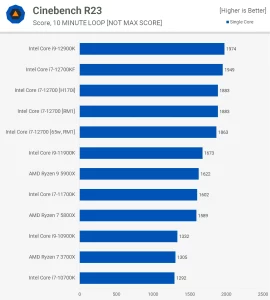Review of Core i7 12700 processor and B660 chipset

It has been almost a few months since Intel introduced the new generation of its desktop processors, the twelfth generation Alder Lake processors. These processors are the first step in Intel’s return to competition. The Alder Lake hybrid architecture is a combination of optimal cores (E cores means Efficiency) and high-power cores (P cores means Performance), and Intel has high hopes for it. One of the processors in this series that has a lot of potential is the Core i7 12700 processor, which we are going to review on the new B660 platform.
Intel Core i7 12700 processor
The Core i7 12700 is a 12-core processor. These 12 cores consist of 8 P cores and 4 E cores. The P and E cores of this model are 100 and 200 MHz lower than the 12700K processor, respectively. The motherboard of this processor in our review is also the MAG B660M Mortar WiFi DDR4 motherboard made by MSI. This motherboard is a good option to show the potential of the Core i7 12700 processor. In addition, there is an opportunity to take a look at the new Intel box cooler, the RM1 air conditioner.
Core i7 12700 processor benchmarks
Let’s start with the Cinebench R23 multi-core benchmark. Combining the 12700 processor and the B660 platform with the powerful Corsair H170i cooler, the test scores 21407, which is only 6% less than the 12700K processor. This rating puts the 12700 next to the Ryzen 9 5900X and above the Core i9 10900K. From here, things get trickier, and this is where the true Alder Lake comes in!
When using the RM1 air conditioner – Intel air conditioner – and without manipulating the BIOS settings, the 12700 processor suffers from a heat bottleneck and its score drops to 19714.
In the Cinebench R23 single-core test, there is no indication of power consumption and heat bottlenecks, and the Core i7 12700 processor reaches a single-core frequency of 4.9 GHz, even with the RM1 cooler. Under these circumstances, the 12700 is only 3% slower than the 12700K, but 16% faster than the Ryzen 9 5900X.
Cinebench R23 single core benchmark
Cinebench R23 Multi-Core Benchmark
energy consumption
When measuring the power consumption of the Core i7 12700 processor, it is found that the power consumption of this processor under the H170i air conditioner is more than the RM1 air conditioner; Although the liquid-cooled processor can reach higher frequencies, its performance is not reduced due to the heat bottleneck.
The reason for this phenomenon is that the processor under the RM1 cooler reaches its maximum allowable temperature of 100 ° C and the RM1 cooler can not dissipate the generated heat. Therefore, this heat returns to the motherboard, increasing the temperature of the VRMs and decreasing their efficiency. As a result, the energy consumption of the system as a whole increases.
Gaming performance of Core i7 12700
When we look at the average performance of the Core i7 12700 processor in 10 games and 1080p resolution, we find that without limiting power consumption and with the installation of a good cooler, this processor fits shoulder to shoulder with the Core i7 12700K processor and the Ryzen 9 5900X processor. It also fails.
By limiting the CPU power consumption to 65 watts and below the RM1 cooler, the 12700 is between the R7 5800X and the R9 5900X. Interestingly, despite limiting power consumption to 65 watts, the 12700 is still about 5 percent faster than the previous generation flagship, the 11900K.
New Intel Cooler Box: Laminar RM1
An important part of this review is related to the new generation of Intel air conditioner, namely RM1 air conditioner. Intel has introduced three new coolers, the RM1 is a mid-range model, and it sits between the lower RS1 cooler and the RH1 upper cooler.
The RM1 is not a bad air conditioner, and if you limit the power consumption of the Core i7 12700 processor to 65 watts, it will work perfectly. But without limiting energy consumption, the temperature of the processor under this cooler reaches 100 degrees and suffers from the phenomenon of heat bottlenecks. In fact, even a cheap air conditioner worth a few hundred thousand tomans has a better performance than this air conditioner! So if you are planning to buy a Core i7 12700 processor, it is better not to count on the RM1 air conditioner too much and buy a good custom air conditioner next to your processor. Therefore, by buying this processor as a tray or without a box, not only do you not lose much, but you can save some money for a good cooler.
Intel B660 platform
Intel has also introduced new chipsets for its twelfth generation of processors, one of which is the B660, the third in the family after the Z690 and Z670. All five Alder Lake host chipsets support Wi-Fi 6E technology, Rapid Storage v19 technology and PCIe 4.0 interface.
Compared to the Z690 chipset, the B660 chipset has a lot of power reduction. Of course, there is no CPU overclocking in this chipset, but fortunately, RAM overclocking is still possible in this chipset. In addition, only 4 fourth-generation DMI x4 lanes are embedded in this chipset, and PCIe 4.0 bandwidth on this platform is halved compared to the Z690 platform. Of course, this is not a problem for the average user at all.
Concluding remarks
The Intel Core i7 12700 processor is a great option and many PC users will use it in their systems. This processor, along with a good cooler, is only 7% slower than the 12700K processor. So if you are not overclocking, the 12700 processor can be a great choice for you. In gaming, the difference between the 12700 and 12700K processors is less, and in some titles, it is less than 1%. All in all, for users who are not overclocking, the Core i7 12700 is worth far more than the 12700K.
The Alder Lake hybrid architecture seems to be a big leap forward from the Comet Lake and Rocket Lake architectures, and it could make up for Intel’s lag behind AMD and the Zen 2 and Zen 3 architectures. But Intel wins the new round of competition with “non-K” processors – the Core i7 12700 being one of them. If the pricing of these processors and the B660 platform is done properly and intelligently, the blue team will leave no room for the red team in this part of the market.
What do you think about this? Can the blue team make up for its backlog and return to its golden position in the processor market? Be sure to let us know in the comments section.

